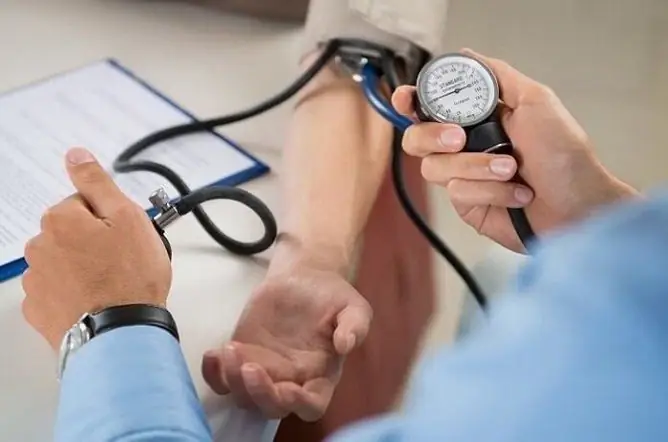- Author Rachel Wainwright [email protected].
- Public 2023-12-15 07:39.
- Last modified 2025-11-02 20:14.
High pulse at normal pressure - what to do?
The content of the article:
- The most common causes of a rapid pulse at normal pressure
-
Varieties of rapid heartbeat
- Sinus heart palpitations
- Paroxysmal tachycardia (PT)
- Ventricular fibrillation
- What are the complaints caused by an increased pulse at normal pressure?
- High pulse at normal pressure: what to do?
-
Frequently asked questions
- Why is it necessary to reduce the high heart rate if the pressure is normal, and the pulse is high, while it does not cause discomfort?
- Why is a high pulse dangerous?
- What pills for tachycardia can be taken at home?
- Does the disease have features in elderly patients?
- Video
A high pulse at normal pressure is referred to as tachycardia. In this case, the heart rate (HR) is recorded at more than 90 (according to other sources - 100) beats per minute. It is characteristic that by the presence of a frequent pulse it is impossible to talk about the development of the disease: tachycardia is ubiquitous in perfectly healthy people.

A high pulse with normal blood pressure is called tachycardia.
The most common causes of a rapid pulse at normal pressure
An increase in heart rate can be both physiological (being a variant of the norm) and pathological in nature.
What can be physiological tachycardia? It develops in a wide range of conditions:
- excessive physical stress;
- psycho-emotional load;
- sudden fright, an attack of panic;
- the use of tonic drinks (strong tea, coffee, energy);
- taking certain medications;
- adaptation of the cardiovascular system when changing microclimate (for example, when traveling to countries with higher humidity and air temperature);
- hyperthermia, when the heart rate increases by an average of ten beats with a rise in temperature for each subsequent degree.
If the increased heart rate is not associated with any pathology, the following patterns will be traced in its development:
- an attack of tachycardia has a clear connection with external influences;
- after the elimination of the provocateur that caused the heart rate jump, the pulse returns to normal within 5-7 minutes;
- an increase in heart rate is not accompanied by headache, noise and ringing in the ears, pain in the chest, flickering of luminous points in front of the eyes, or short-term loss of vision.
A pathological increase in heart rate is not an independent nosology, but acts as a manifestation of any underlying disease. In this case, tachycardia does not necessarily accompany cardiovascular pathology: it can also be caused by endocrine and nervous diseases, and some autoimmune processes.
In this case, the reasons for the rapid heart rate with normal blood pressure (BP) are as follows:
- myocarditis;
- overdose of drugs, including strong narcotic drugs;
- acquired or congenital valvular defects;
- cardiomyopathy;
- ischemic heart disease, including the presence of postinfarction changes in the heart muscle;
- heart surgery;
- abnormal location of the heart chords;
- pathology of the conducting system;
- adrenal tumor;
- hypothalamic syndrome;
- vegetative-vascular dysfunction (neurocirculatory dystonia);
- damage to the thyroid gland;
- changes in hormonal levels in the premenopausal period and in menopause in women.
Varieties of rapid heartbeat
A fast pulse at normal pressure can be represented by three different states.
Sinus heart palpitations
Sinus tachycardia develops with overly active functioning of the cardiac conduction system, when a nerve impulse is habitually generated in the sinus node and spreads through the cells of the myocardium, but with an abnormal frequency. The rhythm of the heartbeat is not disturbed. This type of tachycardia can be both physiological and pathological.
Paroxysmal tachycardia (PT)
Paroxysm, that is, an attack, an unusually rapid pulse (more than 140 heartbeats per minute) develops suddenly. In most cases, the cause of tachycardia is a violation of the adequate circulation of the nerve impulse through the tissues of the heart (its re-entry into already excited myocardial cells, the so-called re-entry mechanism). The focus of activity in such tachycardia can be localized in the ventricles (ventricular PT) or in the overlying structures of the heart (atrioventricular or atrial PT).
Intense paroxysms of increased rhythm can cause a drop in blood pressure. What does such a change in blood pressure mean? It indicates an increase in the severity of the condition.
Ventricular fibrillation
In this case, the heart rate can reach 450 or more beats per minute. Strictly speaking, the chaotic movements of the muscle fibers of the ventricles of the heart cannot be considered a pulse. Normal pressure in this pathology persists for several seconds, after which it begins to rapidly decrease. If emergency care is not provided, the patient's death occurs within a few minutes.
What are the complaints caused by an increased pulse at normal pressure?
Patients with tachycardia have:
- palpitations (patients note that they physically feel the heart beating in the chest);
- transient shortness of breath that stops after the normalization of the pulse;
- pallor of the skin or, conversely, hyperemia;
- cold sweat;
- general weakness.
When the heart rate is stable and accompanies the patient almost constantly, complaints of a feeling of fatigue and poor exercise tolerance will prevail.
If a high pulse arises spontaneously, paroxysmally, then complaints will arise precisely during the attack: sharp sweating, hot flashes, or, on the contrary, cold extremities and pallor of the face, a feeling of unsatisfactory inhalation, and so on.
High pulse at normal pressure: what to do?
Treatment of tachycardia against the background of normal blood pressure should be carried out depending on the form of pathology, taking into account the existing concomitant diseases, limitations and individual characteristics of the patient's body.
To determine the therapeutic tactics, it is necessary to seek the advice of a cardiologist; self-medication in this case is unacceptable.

Ventricular fibrillation - an extreme degree of tachycardia that requires emergency measures
Most often, large pulse therapy is based on taking beta-blockers. These drugs help reduce the sensitivity of receptors located in the tissues of the heart to the effects of biologically active substances; to reduce the speed of propagation of a nerve impulse along the conducting system; weaken the excitability of cardiac structures.
In addition to adrenergic blockers, with tachycardia, drugs from the groups of antiarrhythmics, metabolic, sedatives and other drugs are prescribed (depending on the origin and severity of the pathology).
Frequently asked questions
Why is it necessary to reduce the high heart rate if the pressure is normal, and the pulse is high, while it does not cause discomfort?
A constant high pulse contributes to accelerated wear and tear of the heart muscle, significantly reducing its resource. In addition, it significantly increases the likelihood of developing concomitant diseases of the circulatory system.
Why is a high pulse dangerous?
If the resting heart rate systematically rises above 100 or 110 beats per minute and continues to increase, the risk of developing fibrillation, that is, a sudden chaotic contraction of the muscle fibers of the heart, increases significantly.
What pills for tachycardia can be taken at home?
A specialist will advise you on how to lower your heart rate on your own. It is strongly not recommended to take medications on the advice of relatives or friends who are already receiving such treatment. It is important to remember that therapy is prescribed individually in each case: taking into account all available indications, contraindications, individual characteristics and associated factors.
Does the disease have features in elderly patients?
For older people, the heart rate is the same as for younger people - from 60 to 80 heart rate per minute. But the older the patient is, the lower the upper possible pulse threshold is set for him. The following formula for calculating the maximum heart rate is very popular: "220 - age in years". This means that for a 70-year-old person, the maximum safe heart rate at the highest load will be 150 beats / min.
Video
We offer for viewing a video on the topic of the article.

Olesya Smolnyakova Therapy, clinical pharmacology and pharmacotherapy About the author
Education: higher, 2004 (GOU VPO "Kursk State Medical University"), specialty "General Medicine", qualification "Doctor". 2008-2012 - Postgraduate student of the Department of Clinical Pharmacology, KSMU, Candidate of Medical Sciences (2013, specialty "Pharmacology, Clinical Pharmacology"). 2014-2015 - professional retraining, specialty "Management in education", FSBEI HPE "KSU".
Found a mistake in the text? Select it and press Ctrl + Enter.






